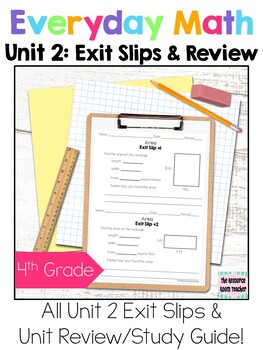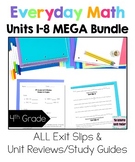4th Grade Everyday Math Unit 2 Exit Slips & Review/Study Guide BUNDLE!
- Zip
Products in this Bundle (4)
Also included in
- Are you looking for a way to check in with your students throughout each unit of Everyday Math? Would your students benefit from reviewing the topics covered in Units 1-8 of Everyday Math before each assessment? This mega bundle is just what you need! *All answer keys included!*Want to try before yoPrice $29.99Original Price $52.50Save $22.51
Description
This bundle pack is full of supplemental materials for 4th Grade Everyday Math Unit 2 (4th Edition)! This resource includes 13 Exit Slips, covering each individual topic in Unit 2 (topics listed below), and an end of unit review (that could also be used as a clear and organized replacement for the assessment!) *Answer keys included for all exit slips and review!*
The concepts included are:
- Area - Identify length & width of a given rectangle; find area (in inches & feet)
- Multiplication - Arrays, Factors, Multiples, Fact Practice & Word Problems
- Identify lines of symmetry
- Identify properties of quadrilaterals
- In & Out Tables - "What's My Rule?" and converting between minutes & seconds
Looking for more Everyday Math supplemental materials?
4th Grade Unit 1 Exit Slips & Review Bundle
4th Grade Unit 3 Exit Slips & Review Bundle
**Get the Bundle Packs & save!:
4th Grade Units 1-4 EDM Review BUNDLE PACK
4th Grade Units 5-8 EDM Review BUNDLE PACK
4th Grade Everyday Math Units 1-8 MEGA BUNDLE! *Best price! Less than $2 per review!*
Reviews/Study Guides
Unit 1:
Unit 3:
Unit 4:
Unit 5:
Unit 6:
Unit 7:
Unit 8:




